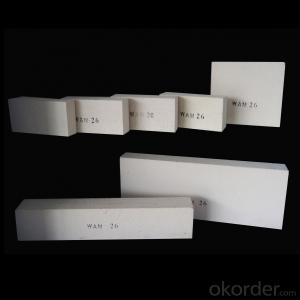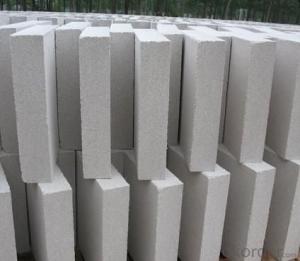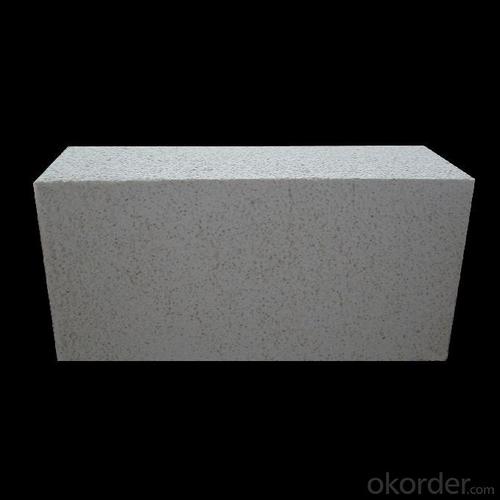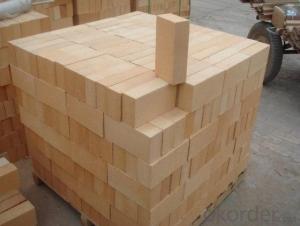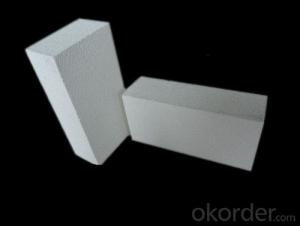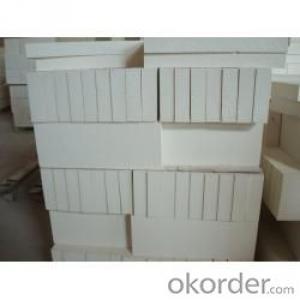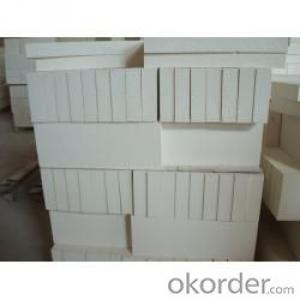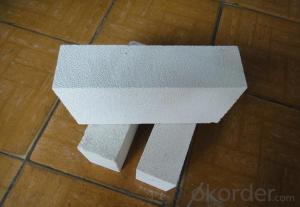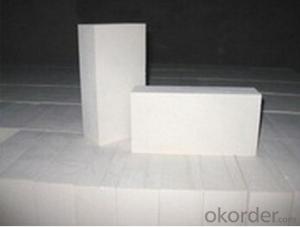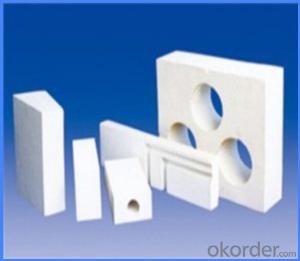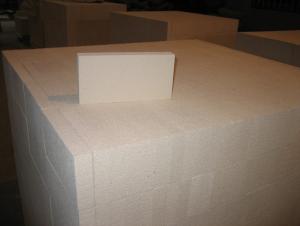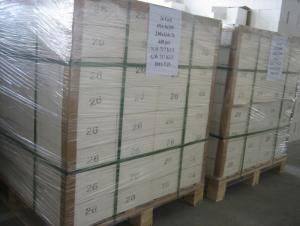Insulating Fire Brick - Refractory Mullite Insulating Refractory Brick JM 42
- Loading Port:
- Shanghai
- Payment Terms:
- TT OR LC
- Min Order Qty:
- 20 m.t.
- Supply Capability:
- 20 m.t./month
OKorder Service Pledge
OKorder Financial Service
You Might Also Like
General Information
CMAX insulating firebricks are classified under temperature between 1300℃ to 1700℃, manufactured from high purity alumina clay.
1. Lower content of iron, alkaline and impurities, good high temperature properties.
2. Homogeneous structure, light weight, energy saving because lower heat storage in the furnace during cooling cycles.
3. High strength, good thermal shock resistance under high temperature.
Feature
Light weight and low thermal conductivity
Low heat storage
Low iron and impurities
Application of Insulating brick
Metallurgical Industry: blast furnace, hot blast furnace, heating furnace, etc..
Petrochemical Industry: ethylene cracking furnace, hydrogen furnace, the main furnace, heating furnace, etc..
Ceramic industry: roller kiln, kiln, etc..
Advantages of heat insulation brick
Low thermal conductivity: many air holes will bring good thermal insulation effect, energy saving.
High crushing strength: high crushing strength, volume stability.
Low heat storage: small heat storage, absorb more heat, energy-saving effect is obvious.
Technical Data
ITEM | GJM30 | GJM28 | GJM26 | GJM23 |
Classification Temperature, ℉/℃ | 3000/1650 | 2800/1540 | 2600/1430 | 2300/1260 |
Bulk Density,g/cm³ | ≤1.0 | ≤0.9 | ≤0.8 | ≥0.5 |
Reheating Linear Change, % | ≤0.9 (1550℃,12 h) | ≤0.8 (1510℃,12 h) | ≤0.7 (1410℃,12 h) | ≤0.5 (1230℃,12 h) |
Al2O3 Content, % | ≥75 | ≥65 | ≥55 | ≥45 |
Fe2O3 Content, % | ≤0.5 | ≤0.6 | ≤0.7 | ≤1.0 |
Thermal Conductivity: | ||||
800℃, w/m.k | ≤0.39 | ≤0.37 | ≤0.35 | ≤0.18 |
1000℃, w/m.k | ≤0.43 | ≤0.41 | ≤0.39 | ≤0.20 |
1200℃, w/m.k | ≤0.48 | ≤0.46 | ≤0.43 | --- |
Insulating brick
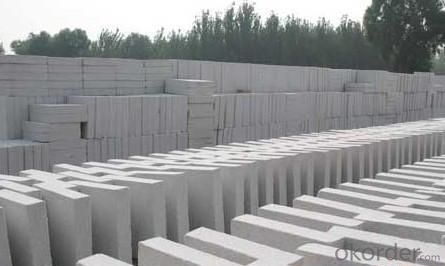
- Q: Can insulating fire bricks be used in high-temperature insulation panels?
- Yes, insulating fire bricks can be used in high-temperature insulation panels. Insulating fire bricks are designed to withstand high temperatures and provide excellent thermal insulation. They are made from lightweight refractory materials that have low thermal conductivity, allowing them to effectively reduce heat transfer. These bricks can be used in various applications, including furnaces, kilns, and high-temperature insulation panels. They are capable of withstanding temperatures up to 3000°F (1650°C) and can effectively retain heat, making them an ideal choice for high-temperature insulation panels.
- Q: Can insulating fire bricks be used in high-temperature kilns and furnaces?
- Yes, insulating fire bricks can be used in high-temperature kilns and furnaces. Insulating fire bricks are specially designed to withstand extreme heat and provide excellent insulation properties. They are made from lightweight refractory materials, such as clay and silica, which have high melting points and low thermal conductivity. These bricks can effectively retain heat, reducing energy loss and improving the efficiency of the kiln or furnace. Additionally, insulating fire bricks have good resistance to thermal shock, meaning they can handle rapid temperature changes without cracking or breaking. This makes them suitable for use in high-temperature applications where the kiln or furnace may go through frequent heating and cooling cycles. Overall, insulating fire bricks are an ideal choice for insulating and protecting high-temperature kilns and furnaces.
- Q: Do insulating fire bricks require any special storage conditions?
- Yes, insulating fire bricks require special storage conditions. They should be stored in a dry and well-ventilated area to prevent moisture absorption, which could lead to cracking or damage when exposed to high temperatures. Additionally, they should be protected from direct sunlight and extreme temperature variations to maintain their structural integrity.
- Q: Can insulating fire bricks be used in the construction of crucibles?
- Insulating fire bricks can indeed be utilized for constructing crucibles. These bricks are crafted from lightweight materials like clay and silica, boasting remarkable thermal insulation properties. Consequently, they are highly suitable for scenarios that require the preservation of high temperatures and minimal heat loss, such as crucible construction. Crucibles, extensively employed in industries like metallurgy and chemistry, serve the purpose of containing and melting materials at exceedingly elevated temperatures. By incorporating insulating fire bricks into crucible construction, heat loss is curtailed, energy efficiency is enhanced, and a more consistent temperature is maintained within the crucible, ultimately resulting in improved overall performance. Furthermore, the lightweight nature of these fire bricks facilitates easier handling and installation, further augmenting their appropriateness for crucible construction.
- Q: Can insulating fire bricks be used in ceramic fiber blankets?
- No, insulating fire bricks cannot be used in ceramic fiber blankets. Insulating fire bricks are solid and rigid, while ceramic fiber blankets are flexible and designed for insulation purposes. They serve different functions and have different properties, making them incompatible for use together.
- Q: Can insulating fire bricks be used for insulation in smelting furnaces?
- Smelting furnaces can utilize insulating fire bricks for insulation purposes. These bricks are specifically designed to endure high temperatures while providing exceptional insulation capabilities. By possessing a low thermal conductivity, they can effectively retain heat within the furnace, preventing energy loss. This quality makes them an ideal option for smelting furnaces that necessitate elevated temperatures. Moreover, insulating fire bricks are lightweight, facilitating easy handling and installation within the furnace. Their durability and resistance to thermal shock allow them to withstand the extreme conditions of smelting processes. In conclusion, insulating fire bricks are a dependable and efficient choice for insulation in smelting furnaces.
- Q: Can insulating fire bricks be used for insulation in oil refineries?
- Yes, insulating fire bricks can be used for insulation in oil refineries. These bricks have excellent thermal insulation properties and can withstand high temperatures, making them suitable for insulation applications in oil refineries where heat is generated. They can help reduce heat loss and increase energy efficiency in the refining process.
- Q: Can insulating fire bricks be used in wastewater treatment plants?
- Yes, insulating fire bricks can be used in wastewater treatment plants. They are often used in the construction of furnaces, kilns, and other high-temperature applications in these plants to provide thermal insulation and retain heat efficiently.
- Q: Can insulating fire bricks be used as a lining for chimneys?
- Yes, insulating fire bricks can be used as a lining for chimneys. These bricks are designed to withstand high temperatures and provide insulation, making them suitable for lining chimneys and protecting them from heat damage.
- Q: Can insulating fire bricks be used in waste incineration plants?
- Yes, insulating fire bricks can be used in waste incineration plants. Insulating fire bricks are designed to withstand high temperatures, making them suitable for use in the extremely hot environment of waste incineration plants. These bricks are made from lightweight materials that have excellent thermal insulation properties, which helps to reduce heat loss and improve energy efficiency in the incineration process. Additionally, insulating fire bricks have good resistance to chemical and thermal shock, which is important in waste incineration plants where various types of waste materials are burned. Overall, the use of insulating fire bricks in waste incineration plants can contribute to better insulation, higher energy efficiency, and improved performance of the incineration process.
Send your message to us
Insulating Fire Brick - Refractory Mullite Insulating Refractory Brick JM 42
- Loading Port:
- Shanghai
- Payment Terms:
- TT OR LC
- Min Order Qty:
- 20 m.t.
- Supply Capability:
- 20 m.t./month
OKorder Service Pledge
OKorder Financial Service
Similar products
Hot products
Hot Searches
Related keywords


